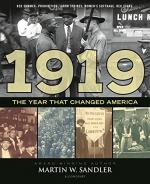
|
| Name: _________________________ | Period: ___________________ |
This test consists of 5 multiple choice questions, 5 short answer questions, and 10 short essay questions.
Multiple Choice Questions
1. During World War I, molasses and what substance were mixed with ammonium nitrate in order to make explosives?
(a) Napalm.
(b) Water.
(c) Vinegar.
(d) Gunpowder.
2. Henry A. Stinson, the secretary of war in 1913, promised that if the suffragists encountered trouble during Alice Paul's parade, he would send the cavalry from which nearby fort?
(a) Fort Knox.
(b) Fort Myer.
(c) Fort Collins.
(d) Fort Briggs.
3. "Over" how many "individuals and companies filed lawsuits against USIA" (29) in the aftermath of the Great Molasses Flood?
(a) 300.
(b) 425.
(c) 125.
(d) 25.
4. Sandler points out that the battle for women to attain the right to vote was waged for over how many years before it was resolved?
(a) 70.
(b) 10.
(c) 50.
(d) 30.
5. In front of what location are the suffragists picketing, in the photograph included just prior to the opening of Chapter 2: Women Get the Vote?
(a) The Executive Mansion.
(b) The Empire State Building.
(c) The Pentagon.
(d) The Washington Memorial.
Short Answer Questions
1. In what year did Alice Paul and Lucy Burns form the National Woman's Party (NWP), a group Sandler calls "the most effective of all the women's groups" (47)?
2. What job did the man have who ended up being tossed into the harbor after narrowly escaping other perils in the Great Molasses Flood?
3. How many individuals did Ogden find criminally liable for the tragic events of the Great Molasses Flood?
4. In what month of 1919 did the Great Molasses Flood take place?
5. In what month was the Seneca Falls Convention held?
Short Essay Questions
1. Analyze a 1919 reporter's use of literary devices to vividly depict the Great Molasses Flood.
2. What "effective tactics" (34) used by suffragettes are portrayed in the photograph included just prior to the start of Chapter 2: Women Get the Vote?
3. How many "tons of raw molasses poured out" (15) of the container, how high were the waves it produced, and how fast did the molasses move during the Great Molasses Flood?
4. Discuss an instance when Sandler includes or highlights an element of absurdity in order to connect with a young audience in Chapter 1: An Amazing Event.
5. What role did elevated railroad brakeman Royal Albert Leeman play in the Great Molasses Flood?
6. Describe the very first "suffrage parade" (40) in American history.
7. What conclusion does Sandler draw about the suffragettes' awareness of their predecessors in the field of civil disobedience?
8. What clues point to the conclusion that USIA likely knew that the molasses container needed attention before the Great Molasses Flood occurred?
9. What were the two most effective general strategies employed by the National Woman's Party in their pursuit of women getting the right to vote?
10. For what reasons were the Western states more progressive in relation to women's voting rights than were the Eastern states?
|
This section contains 1,212 words (approx. 5 pages at 300 words per page) |

|




